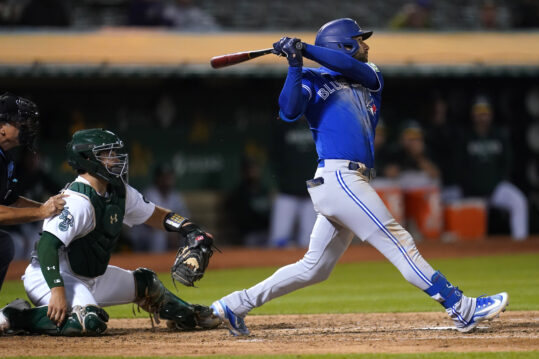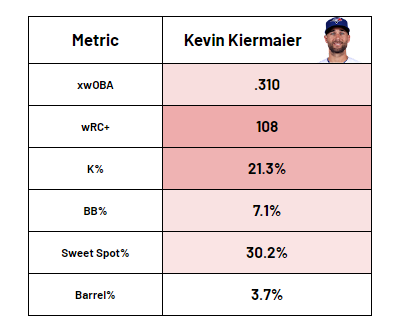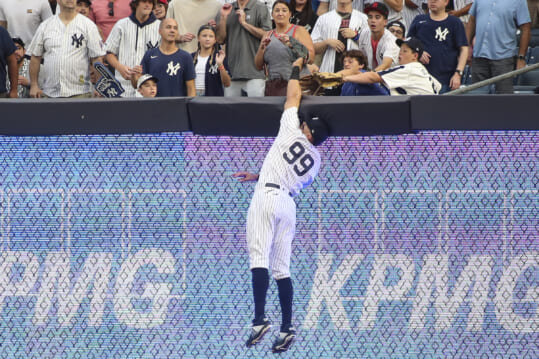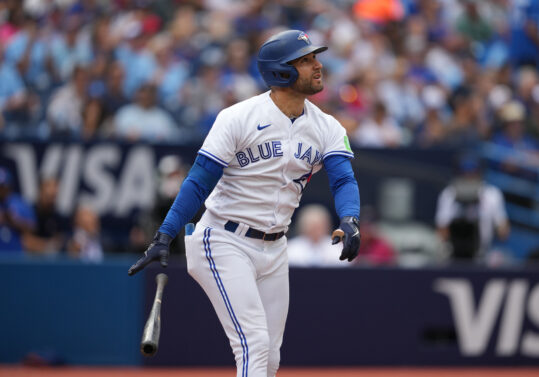
Kevin Kiermaier told reporters after the Yankees’ 5-2 win over the Toronto Blue Jays that enjoyed playing in the Bronx, citing the grass and good numbers offensively in the stadium. The Yankees are without their previously projected centerfielder for 2024 as Jasson Dominguez recovers from Tommy John Surgery. Defensively, the Yankees have been really strong in CF with Aaron Judge and Harrison Bader splitting duties in 2022 and Bader being the starter for the first half of 2023, and while they’re in dire need of offense, the market doesn’t present the bat-first outfielders that we’ve seen in previous free agent classes.
A familiar name to Yankees fans, Kiermaier has spent his entire career in the American League East, spending all but one year of his career with the Rays and now slotting in as the Blue Jays’ reliable centerfielder. One of the best defensive outfielders not just in the game but in the history of the sport, the 33-year-old lefty could provide a stopgap option for the Yankees until Dominguez returns.
- Yankees activate exciting outfield prospect off of IL, remains in Triple-A
- Yankees are ‘actively’ targeting help at 3B at the trade deadline
- The Yankees need to make a big push for this perfect infield trade target
Providing Skills the Yankees Lack Offensively
Two criticisms of the construction of Brian Cashman’s Yankees over the past three years have stemmed from their speed or lack thereof. We’ve seen the Yankees get themselves in a heap of trouble when they’re at the plate due to either poor base running decisions or slow hitters who are prime targets for a back-breaking double play. When Giancarlo Stanton comes up with a runner on first, the inning can completely change if he hits a ball on the ground, even if it’s a play the average big leaguer beats out.
As a team, the Yankees are 29th in BsR (-13.5) and Statcast’s Runner Runs (-8), and while it would be easy to pin most of this on the lumbering Stanton, this is a team-wide issue. He’s simply a piece of the Yankees’ massive oversight in roster construction, as the Yankees are dead last in Sprint Speed (26.7 ft/sec) and were 25th in 2022 (26.9 ft/sec) and 29th in 2021 (26.7 ft/sec). This isn’t to say being fast is more important than hitting well, rather being the slowest team in baseball while also struggling to hit has led to the 2023 Yankees ranking 24th in Runs Scored.
Kiermaier ranks in the 87th Percentile in Sprint Speed, swiping 13 bases in just 14 attempts, the most he’s had in a season since 2019 when he stole 19 bags. The Yankees could use the boost on the speed front, and while they’ve had the speedy Harrison Bader in the past, his 76 wRC+ in 2023 just wasn’t cutting it offensively. Even despite the poor bat, he was still on pace for a 2-2.5 WAR season if he spent the rest of the season in pinstripes, and that’s due to the aforementioned strong speed and Bader’s platinum glove caliber defense.
“Okay, so he’s a left-handed version of Harrison Bader, how does this help the Yankees’ offensive woes?”

One of the biggest differences between Kevin Kiermaier and Harrison Bader comes down to handedness, as since Kiermaier is a lefty, he’s performed a lot better versus RHP. The Yankees are the sixth-best offense in baseball against left-handed pitching in terms of wRC+ (116), and while they’re towards the bottom in Runs Scored, that’s because no team has taken fewer Plate Appearances against southpaws than the Yankees this season. The Yankees need to keep teams honest and make it harder to navigate through the Yankee lineup, and Kiermaier provides that.
This past season, he posted a 110 wRC+ versus RHP, striking out just 20.3% of the time and slugging .442 with seven HRs in 258 Plate Appearances. In his career, that wRC+ is at 103, and that SLG% is a respectable .427, and while being slightly better than average may not appeal to fans, it’s important to note just how big of a difference a 103 wRC+ makes for the Yankees against righties. Let’s do a quick math experiment, and that’s looking at how much better the Yankees’ would have done offensively had they posted a 103 wRC+ against righties in 2023.
Formula: ((wRC+ vs RHP * PA vs RHP) + (wRC+ vs LHP * PA vs LHP))/(Total PA)
Input Values: ((103 * 4505) + (116*1133))/(5638)
Final Number: 105.6
That’s right, if the Yankees were just baseball’s 13th-ranked offense in terms of wRC+ against right-handers, they would have a 106 wRC+, which would tie the Minnesota Twins and Toronto Blue Jays in wRC+ and placed them among the top 10 offenses in baseball. That’s a MASSIVE difference from their 21st-ranked offense in that metric and likely would have put the Yankees squarely in the playoff hunt with a dominant ace in Gerrit Cole, a great bullpen, and the superstar bat of Aaron Judge that can always get hot and put a team on his back.
Harrison Bader, on the other hand, had a mere 37 wRC+ against right-handed pitching, further amplifying the Yankees’ struggles against righties, as their 88 wRC+ was the 26th-worst mark in baseball, and it made him a poor fit for the lineup. Current YES Broadcaster and former Cy Young winner David Cone is one of the most forward-thinking members of the New York media, and he’s spoken on his podcast Toeing The Slab about the Yankees’ need for balance in their lineup.
“How do we construct this roster with an eye towards a little more balance in the lineup, and what led us down that road to having imbalance…and that’s something that I think deserves a good second look at by outside counsel”
-David Cone on the Yankees’ lineup construction
Balance is a term that’s been thrown around by older fans and dismissed by younger fans, and while there are truths on both sides, the Yankees are bad against right-handed pitching this year, and the only way to improve would be to get hitters who profile well against righties. Furthermore, pitches that rely more on horizontal movement (sinkers, sweepers) have been pitches that the Yankees have been brutal against relative to the league, and those are pitches mostly thrown by right-handed pitchers.
The reason behind that stems from the fact that horizontal movement plays better to same-handed batters, and the lack of lefties in the world compared to righties makes it more enticing for a righty to learn a sinker or sweeper versus a lefty. Vertical movement, on the other hand, has the inverse effect, it’s why almost all left-handed pitchers possess a curveball in some capacity. The question now becomes if Kiermaier can hit enough to be a help to the Yankees, and while it’s a volatile profile, it’s certainly one that can still be productive.

Everything in Kiermaier’s profile is average besides the barrel rate, which is well below average, but the all-around okay approach with great speed is easy to project for a wRC+ in the 90s or even above 100 if he can stay healthy. He’s pulling more flyballs than in years past, and Kiermaier even spoke about a different approach at the plate this season. He felt as if he had trouble with his vision and, as a result, began wearing contacts, it’s not a coincidence that he’s posted the best xBA in a season since 2015.
The issues with his profile stem from below-average quality of contact numbers, and that’s going to hamper his ceiling significantly, but Kiermaier also spoke to reporters about centering his game less around selling out for power. In most instances, as with Oswaldo Cabrera, this is a bad thing, but for Kiermaier, this is a much better approach for somebody who didn’t have the raw power to justify really poor contact and strikeout rates. His Swinging Strike Rate fell from 14.9% to 13.7%, his strikeout rate fell from 27.6% to 21.3%, and while his barrel rate has been cut in half, his xwOBA has improved, and so have his results.
Does a high groundball profile work? Not usually, and I’m not going to stray away from the variance that comes with a profile that relies on beating the defensive alignments, especially in the triples category. There are a lot of defensive miscues involved in those triples, and Yankee Stadium isn’t a great ballpark for them, but Rogers Centre isn’t either. With the remodeling done to the ballpark, one would expect that lefties would dominate in the ballpark, but it’s posted a 94 Run Factor versus a 100 Run Factor at Yankee Stadium for left-handed hitters.
It’s a contact-oriented approach that relies on hitting the ball to all fields and maximizing the output on pulled flyballs, but considering what the Yankees struggle with, this will be a nice boost. The offensive projection for Kiermaier should settle around 95 when balancing the likely drop-off in BABIP coupled with the boost he’d get from playing in a more friendly run environment for left-handed hitters. Is he elite? No, but he’s certainly good enough at the plate.
Opening Up the Yankees Defensive Alignments
The Yankees, as mentioned earlier, aren’t a bad defensive team, but Harrison Bader certainly helped anchor their outfield defense. Aaron Judge seems to be on a defensive decline from being the best defensive right fielder in baseball to being just above average, which makes sense, given the limitations placed on him due to the toe. His arm is still remarkable, but he doesn’t possess the strong mobility he had in years past, and Kevin Kiermaier provides an excellent solution to these issues. To clarify, Aaron Judge is still more than capable of playing CF and looking good out there, but to preserve his health, they’ll need a primary option out there.
In the case of Jasson Dominguez, he’s returning from Tommy John Surgery, and affording him the opportunity to return perhaps earlier than expected as a DH-only could help the offense a lot. Kiermaier’s excellence in the outfield has been his calling card throughout his whole career, and he hasn’t skipped a beat defensively. He has 17 Defensive Runs Saved with +11 Fielding Run-Value on the season in center field, making him one of the most valuable defensive players not just in center field but in all of baseball. His range is remarkable with +12 OAA, and while he hasn’t gotten much value out of his arm this year, it’s still as strong as ever.
Kiermaier serves as the anchor for the Yankees’ defense in the outfield, and with Dominguez and Judge having injury questions in 2024, his excellence out there can serve as the way to keep both of them healthy and properly utilized in the structure of their defense. Everson Pereira hasn’t done much with the bat, but his glove in left is certainly encouraging with his speed and arm strength, and if he takes that next step offensively, the Yankees could field a really effective outfield rotation between Pereira, Dominguez, Kiermaier, and Judge, who can play all three outfield spots in a pinch.

Furthermore, it gives the Yankees some fun platoon opportunities, as we mentioned earlier, Kiermaier’s splits versus righties and lefties, and the team’s inability to hit righties. The Yankees could go with a Pereira-Kiermaier-Judge outfield with Dominguez at DH for games against righties, with the modality of the four allowing them to mix and match their exact positioning for the day and figuring out who needs the DH rest, and for lefties, they can go Pereira-Judge-Dominguez, with Kiermaier getting the day off and maybe utilizing DJ LeMahieu (117 wRC+ vs. LHP) or Giancarlo Stanton (152 wRC+ vs. LHP) against southpaws.
Versatility and platooning could be weaponized to help take aging veterans and maximize their value, even if those roles are less than what you originally paid for. Stanton could even patrol right field occasionally against LHP while Dominguez is sidelined with his UCL tear, hoping you get some semblance of value from the rapidly aging outfielder. The Yankees need to realize eventually that their older players are limited and that they need to put those hitters in positions to succeed for the offense to take that next step forward, but with how limited they are defensively, it oftentimes becomes difficult to do that.
You may be reading this and thinking about Kiermaier’s own injury issues, and those are more than a fair concern. The offseason hip surgery Kiermaier did seemed to help him a lot as he played over 120 games for just the fourth time in his career, but he also mentioned how he feels as if grass is better on his body than turf is, and Kiermaier’s home ballpark in Toronto is one of five MLB stadiums to use artificial turf, with Tropicana Field being another, where he called home from 2013-2022.
With smart platoon scenarios and the help of Yankee Stadium’s natural grass, Kiermaier is likely to stay on the field more than he would on turf in Toronto or Tampa Bay, and this isn’t a sentiment unique to him. NFL players often complain about the use of artificial turf over grass, most notably with MetLife Stadium having turf that players constantly get hurt at. Expecting 150 games is unreasonable, but at 120-130, you’re getting a player who will comfortably finish between 2.5-3 WAR on the season.
Now for the final question: what would he cost?
Predicting a Contract and Role for Kiermaier
Kevin Kiermaier is going to be in a unique situation in terms of his free agency, given the myriad of injuries in his career, his age-34 season looming, and his strong play in a weak market for outfielders. You can reasonably expect that Kiermaier will get a multi-year deal as well, leveraging high demand for low supply in his favor. With that being said, let’s look to find early-30s players with a similar value in their walk year to make an educated guess on his contract.
Mark Canha signed a two-year $26.5 million deal with a third-year club option that came at $11.5 million for the 2024 season. Coming off of a season where he posted a 3.0 fWAR and 116 wRC+ in 141 games, Canha had put up a career-worst -11 DRS in 2021, which is surprising considering he’s held his own in all three outfield spots since signing his contract with the Mets and being traded to the Brewers this past deadline.
Kiermaier would enter the market with two years of inflation, a similar walk year, but less certainty about how many games he could play as he was a year older than Canha entering the market and has a much more concerning injury history. Sure, the hip surgery held up in year one, but it’s not unreasonable to ask what it would look like in year two. With all of these factors in mind, I think they roughly balance each other out, and with Kiermaier making just $9 million on a one-year deal this year, I think a two-year $27 million deal would work for both the Yankees and Kiermaier.

$13 million a year could be seen as a massive overpay for an outfielder who carries the same low-ceiling bat and injury-prone profile that fans have grown sick of. They tried this with Harrison Bader, why double-dip in the player archetype that yielded a return that the Yankees got the short end of the stick on? Well, because these are different players and different scenarios. High-variance play exists for most players, and that’s because most players aren’t superstars.
Deal rotten batted ball luck? Suffer a small injury that alters your mechanics? Have a weird Spring Training and get off to a poor start? These are all things that can tank a role player’s season, and it’s important to understand that outcomes for players under the same archetype vary. There are reasons why that player will or won’t succeed, and it’s up to variance and league trends to determine whether that player will succeed or not offensively in a given season.
The flaws he has offensively are masked against righties, slugging .442 and hitting seven HRs in 258 PAs against them this past season, a result of pulling 39.7% of flyballs against them and putting the ball in play often (20.2% K%). Kiermaier may not be a perfect hitter, we don’t know if he’s even an average one, but his deficiencies with a southpaws lineup with the Yankees’ roster strength of having great numbers against lefties due to their abundance of righties.
Injury-wise, the grass that Kiermaier cites as easier on his body is the same grass we see in Yankee Stadium, a ballpark he said himself he enjoys playing in. It may not completely keep him healthy, and using him nearly exclusively against right-handed pitching may not make him a good hitter, but the Yankees have a hole in center field, and it’s shaped like Kevin Kiermaier.